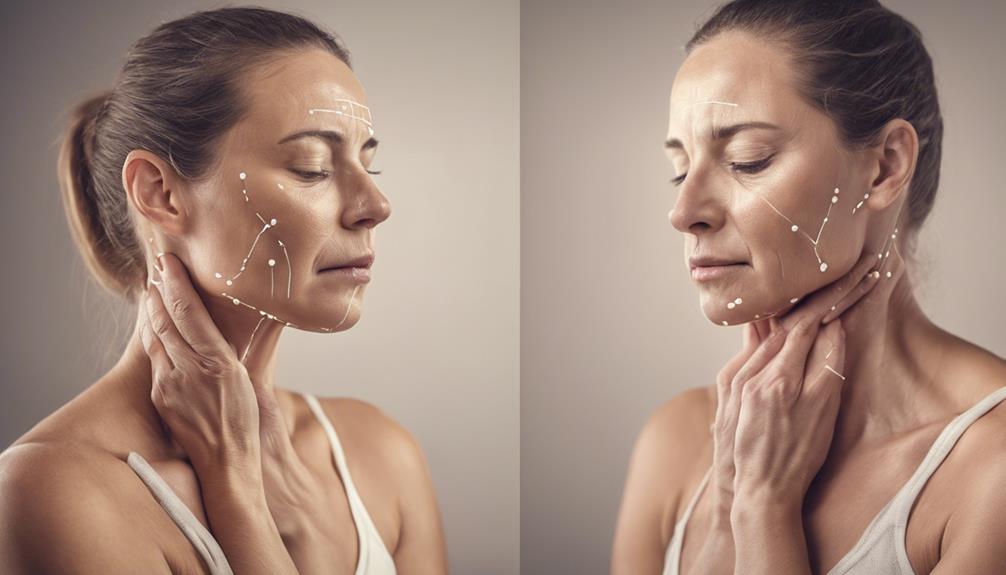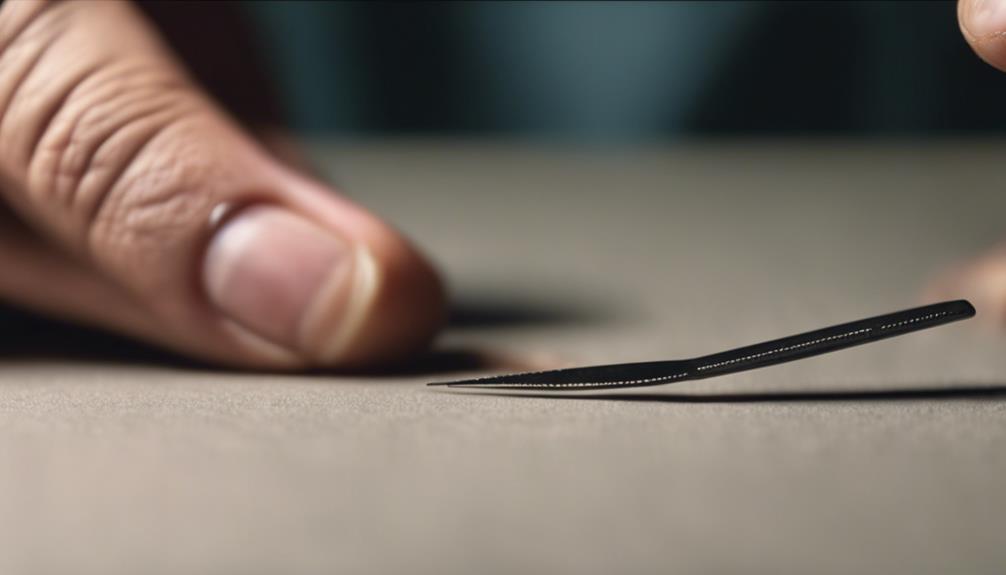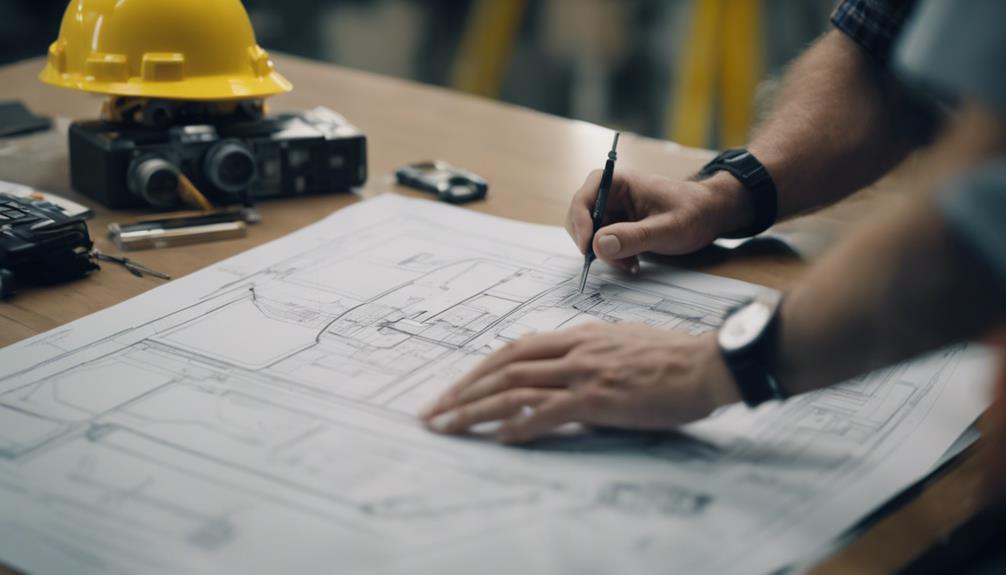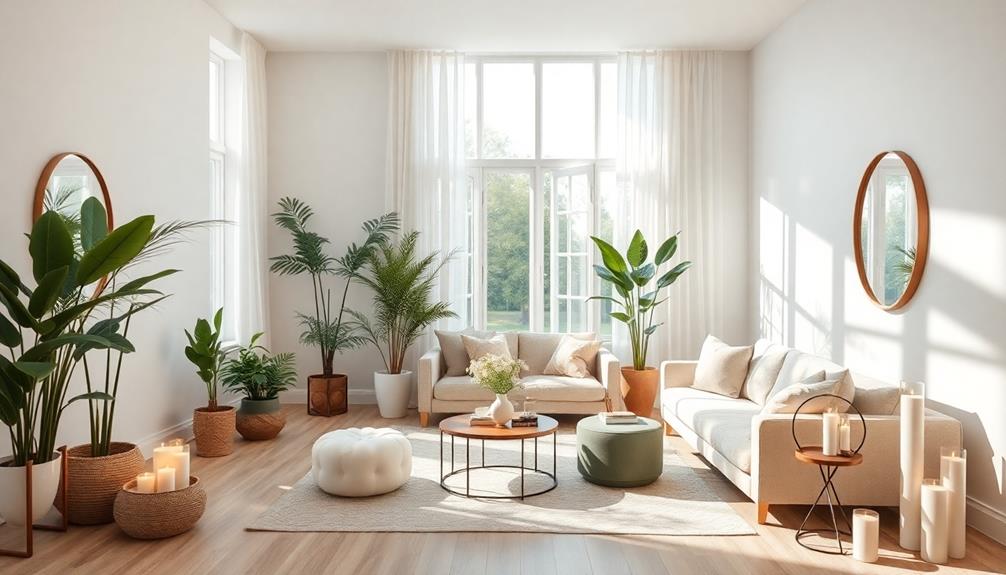To get rid of a double chin without surgery, you can try non-surgical methods like Kybella or CoolSculpting Elite that target excess fat effectively. Neck rolls and chin lifts are great exercises to strengthen muscles and tone your chin area. Make sure to maintain good posture and consider other non-invasive treatments like deoxycholic acid injections for best results. There are various options available to help you address your double chin concerns and enhance your overall appearance. Explore these tips for a more defined jawline and neck without the need for surgical intervention.
Key Takeaways
- Neck exercises like chin lifts and rolls tone muscles and reduce double chin appearance.
- Consider non-surgical options like Kybella, dermal fillers, CoolSculpting Elite, Ultherapy, or laser liposuction.
- Facial exercises, including cheek swishing, help reduce fat and tighten skin in the chin area.
- Non-invasive treatments like deoxycholic acid injections, cryolipolysis, and vacuum-pressured devices are effective.
- Mesotherapy provides additional non-surgical methods for eliminating double chin fat.
Understanding Double Chin
Understanding a double chin involves recognizing the excess fat accumulation between the chin and neck area. This accumulation of fat, also known as submental fullness, can be influenced by factors such as genetics, aging, weight gain, and poor posture.
Skin elasticity plays a role in the appearance of a double chin, as reduced elasticity can exacerbate the sagging in the neck area.
When it comes to non-surgical treatments for addressing a double chin, it's pivotal to understand the root causes. By identifying the factors contributing to fat accumulation in the neck area, individuals can better explore treatment options that target these specific issues.
Whether it's through lifestyle changes, facial exercises, or cosmetic procedures, knowing the underlying reasons for a double chin is the first step towards choosing the most effective solution for each unique situation.
Causes of Double Chin

Excess weight and fat accumulation in the chin and neck area are primary contributors to the formation of a double chin. Several factors can lead to the development of a double chin:
- Excess Chin Fat: When fat accumulates in the area under the chin, it can create a double chin due to the increased volume in that specific area.
- Aging and Decreased Skin Elasticity: As you age, the skin under your chin loses elasticity, causing it to sag and appear fuller, contributing to a double chin.
- Poor Posture and Weak Neck Muscles: Maintaining poor posture and having weak neck muscles can worsen the appearance of a double chin as it affects the overall muscle tone in the neck and chin area.
- Genetics, Weight Gain, and Aging: Factors like genetics, weight gain, and the natural aging process can all play a role in the accumulation of excess fat in the area under the chin, leading to the formation of double chins.
Double Chin Treatments

Various non-surgical treatments are available to address double chins, offering alternatives to invasive procedures for those seeking to improve the appearance of their chin and neck area.
Non-surgical options for reducing a double chin include injectables such as Kybella and dermal fillers, providing immediate results by targeting and reducing excess fat under the chin.
CoolSculpting Elite is a procedure that freezes fat cells beneath the chin without the need for surgery or downtime, aiding in fat reduction.
Ultherapy utilizes ultrasound technology to tighten and lift the skin on the neck and chin area, promoting skin tightening.
Laser liposuction is another option that can specifically target and eliminate excess fat under the chin, enhancing the definition of the jawline.
Additionally, radiofrequency treatments like Thermage help tighten the skin and improve jawline definition without the necessity of surgery, offering various treatment options for individuals looking to address their double chin without going under the knife.
Double Chin Exercises

Strengthening your neck muscles and reducing fat under your chin can be effectively achieved through targeted double chin exercises. These exercises not only help in toning and tightening the chin area but also contribute to a more sculpted appearance.
Here are some key exercises to help you combat that double chin:
- Neck Rolls: Gentle neck rolls can strengthen neck muscles and reduce the appearance of a double chin.
- Chin Lifts: Chin lifts target the jawline and help in toning the chin area.
- Facial Exercises: Performing facial exercises daily can aid in reducing fat under the chin and tightening the skin.
- Cheek Swishing: Cheek swishing exercises are effective in targeting excess fat in the chin and neck region.
Consistent practice of these double chin exercises can complement other treatment options for a more effective reduction in the appearance of a double chin.
Other Treatment Options

To explore alternative methods for reducing a double chin without surgery, consider non-invasive treatment options that target and eliminate excess fat under the chin area.
Deoxycholic acid injections can dissolve fat cells in the chin over a few weeks, while cryolipolysis freezes and eliminates fat cells through apoptosis.
Vacuum-pressured devices offer another non-surgical approach by freezing fat cells to induce natural elimination.
Non-surgical treatments like mesotherapy provide additional options for those seeking double chin reduction without going under the knife.
Procedures such as CoolSculpting and injection lipolysis specifically target submental fat through non-invasive means.
These treatments aim to contour and slim the chin area without the need for invasive surgery, making them attractive options for individuals looking to address their double chin without undergoing a surgical procedure.
Frequently Asked Questions
How to Fix a Double Chin Without Surgery?
To fix a double chin without surgery, consider non-invasive options like Kybella injections, CoolSculpting Elite, Ultherapy, laser liposuction, and radiofrequency treatments. These treatments can help dissolve fat cells, tighten skin, and define your jawline effectively.
How Can I Lose My Double Chin Fast?
To lose your double chin fast, focus on facial exercises, consider fat-dissolving injections, or opt for non-invasive dermal fillers. Prioritize consistent effort to see noticeable results. Remember, seeking professional advice is key for the best approach tailored to your needs.
How to Reduce Double Chin in 7 Days?
To reduce double chin in 7 days, try chin lifts, neck rolls, and jaw release exercises daily. Stay hydrated, eat well, and use firming creams. Consistent effort with facial exercises and good posture can visibly improve your chin in a week.
Does Chewing Gum Reduce Double Chin?
Chewing gum can help strengthen jaw muscles and tone the chin and neck area. While it may not eliminate a double chin alone, incorporating gum chewing into your routine, along with exercise and healthy habits, can promote muscle tone for a more defined jawline.
Conclusion
So there you have it – say goodbye to that pesky double chin without going under the knife! By incorporating some simple exercises and making a few lifestyle changes, you can tighten and tone your neck and jawline in no time.
Remember, Rome wasn't built in a day, so be patient and consistent with your efforts. Soon enough, you'll be rocking that selfie angle like a pro!










